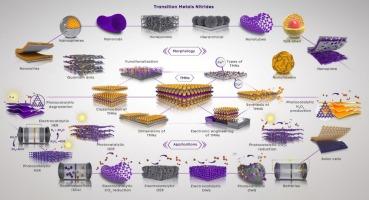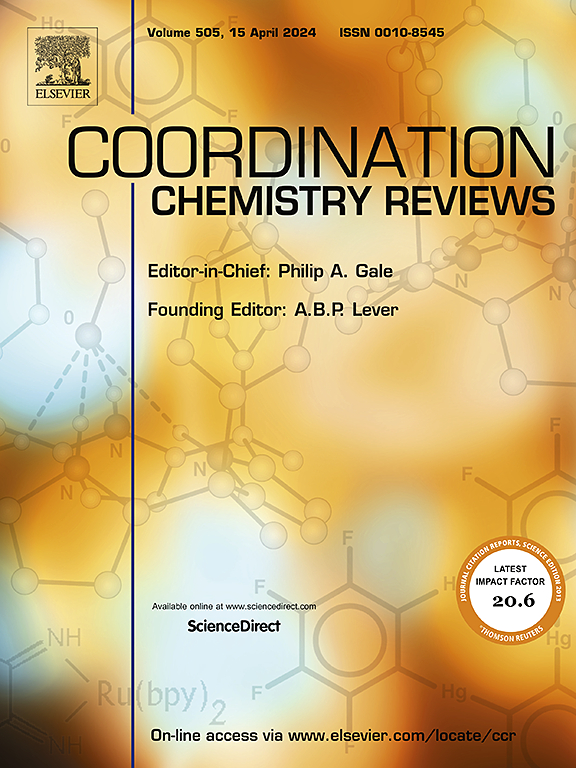A comprehensive Review based on the synthesis, properties, morphology, functionalization, and potential applications of transition metals nitrides
IF 23.5
1区 化学
Q1 CHEMISTRY, INORGANIC & NUCLEAR
引用次数: 0
Abstract
Transition metal nitrides (TMNs) are emerging as versatile materials with significant potential across various fields due to their unique properties and functionalities. This review provides a comprehensive overview of TMNs, covering their crystal structure, stability, and the unique advantages they offer. TMNs exhibit superior catalytic activity, lower sintering sensitivity, and high selectivity, while operating at reduced temperatures. Density functional theory (DFT) studies have addressed their diverse properties, including electronic, optical, vibrational, plasmonic, mechanical, bulk, magnetic, structural, and morphological characteristics. The review categorizes TMNs into different types: unitary, binary, ternary, and quaternary nitrides, and explores various synthesis methods such as ammonolysis, chemical vapor deposition (CVD), electrodeposition, and pyrolysis. Additionally, it discusses the classification of TMNs into single metal-source nitrides and composite metal-source nitrides, highlighting materials like Fe![]() N, Co
N, Co![]() N, and Ti
N, and Ti![]() N. Similarly, the functionalization strategies are also examined, covering boron-based, cyanide-based, and graphene-based TMNs etc. among others. The review evaluates the morphology of TMNs, including nanoflowers, nanospheres, and nanowires, and their influence on performance. Finally, the applications of TMNs are explored in detail, focusing on their performance in photocatalytic reactions (hydrogen (H2) evolution, oxygen (O2) evolution, overall water splitting, hydrogen peroxide (H2O2) production, carbon dioxide (CO2) reduction, and degradation), electrocatalysis (H2 evolution reaction, O2 evolution reaction, overall water splitting, CO2 reduction), energy storage (batteries and supercapacitors), and solar cells. This synthesis of material highlights the extensive use and future promise of TMNs in enhancing technical advancements. This study aims to provide an extensive foundation that covers every aspect of TMNs, with a particular focus on their many functional features, unique morphologies, and dimensions. Our comprehensive approach provides readers with an in-depth understanding of TMNs properties and potential applications, setting our review apart through its extensive coverage and detailed analysis. This thorough overview highlights the enormous potential of TMNs to drive advancements in various technological and scientific fields.
N. Similarly, the functionalization strategies are also examined, covering boron-based, cyanide-based, and graphene-based TMNs etc. among others. The review evaluates the morphology of TMNs, including nanoflowers, nanospheres, and nanowires, and their influence on performance. Finally, the applications of TMNs are explored in detail, focusing on their performance in photocatalytic reactions (hydrogen (H2) evolution, oxygen (O2) evolution, overall water splitting, hydrogen peroxide (H2O2) production, carbon dioxide (CO2) reduction, and degradation), electrocatalysis (H2 evolution reaction, O2 evolution reaction, overall water splitting, CO2 reduction), energy storage (batteries and supercapacitors), and solar cells. This synthesis of material highlights the extensive use and future promise of TMNs in enhancing technical advancements. This study aims to provide an extensive foundation that covers every aspect of TMNs, with a particular focus on their many functional features, unique morphologies, and dimensions. Our comprehensive approach provides readers with an in-depth understanding of TMNs properties and potential applications, setting our review apart through its extensive coverage and detailed analysis. This thorough overview highlights the enormous potential of TMNs to drive advancements in various technological and scientific fields.
Novelty of this study
The novelty of this review on TMNs lies in its comprehensive and multidimensional approach, presenting a detailed exploration of all critical aspects of such materials. The review offers a broad platform covering their diverse morphologies, structural types, and synthesis techniques, while emphasizing their extensive range of functionalities. Notably, it integrates an analysis on the crystalline structures of TMNs, their varied properties, and dimensionality (from 0D to 3D), which are key factors in determining their catalytic performance, stability, and applications in various fields. The review organizes TMNs into unitary, binary, ternary, and quaternary nitrides, emphasizing the compositional and structural differences that directly affect their characteristics and applications.
This work, for the first time, illustrates the benefits of certain functional units within TMNs, such as boron and platinum, and provides insights regarding how various synthesis processes facilitate material modification. Additionally, the review comprehensively explores the diverse morphologies of TMNs and their impact on catalytic performance and stability. By systematically categorizing TMN structures such as nanoflowers, nanospheres, nanorods, nanowires, nanotubes, quantum dots, honeycomb, yolk-shell, and hierarchical structures, it demonstrates how these morphologies enhance surface area, electrons transfer, and catalytic selectivity.
Moreover, the review provides extensive analysis of the applications of TMNs in photocatalysis, electrocatalysis, and energy storage technologies. It explores into their roles in H2 and O2 evolution reactions, overall water splitting, H2O2 production, CO2 reduction, pollutant degradation, and their use in advanced energy storage devices like batteries, supercapacitors, and solar cells. This comprehensive analysis highlights the versatility and potential of TMNs in advancing breakthroughs in clean energy and environmental technology.
Overall, the review provides an inclusive, detailed perspective that distinguishes it from previous studies.

综述了过渡金属氮化物的合成、性质、形态、功能化及应用前景
过渡金属氮化物(TMNs)由于其独特的性能和功能,在各个领域都具有巨大的潜力。这篇综述提供了TMNs的全面概述,包括它们的晶体结构,稳定性和它们提供的独特优势。TMNs表现出优异的催化活性,较低的烧结灵敏度和高选择性,同时在较低的温度下工作。密度泛函理论(DFT)研究了它们的各种特性,包括电子、光学、振动、等离子体、机械、体积、磁性、结构和形态特征。本文将TMNs分为一元氮化物、二元氮化物、三元氮化物和季氮化物,并探讨了氨解、化学气相沉积(CVD)、电沉积和热解等多种合成方法。此外,还讨论了TMNs的分类,分为单金属源氮化物和复合金属源氮化物,重点介绍了FeN, CoN和TiN等材料。同样,功能化策略也进行了研究,包括硼基、氰基和石墨烯基TMNs等。本文综述了纳米纳米粒子的形态,包括纳米花、纳米球和纳米线,以及它们对性能的影响。最后,详细探讨了TMNs在光催化反应(氢(H2)析出、氧(O2)析出、整体水分解、过氧化氢(H2O2)生成、二氧化碳(CO2)还原和降解)、电催化(H2析出反应、O2析出反应、整体水分解、CO2还原)、储能(电池和超级电容器)和太阳能电池中的应用。这种材料的合成突出了TMNs在促进技术进步方面的广泛应用和未来前景。本研究旨在提供一个广泛的基础,涵盖tmn的各个方面,特别关注它们的许多功能特征,独特的形态和尺寸。我们的综合方法为读者提供了对TMNs特性和潜在应用的深入了解,通过其广泛的覆盖范围和详细的分析,使我们的评论与众不同。这一全面的概述强调了TMNs在推动各种技术和科学领域进步方面的巨大潜力。本研究的新颖性本综述的新颖性在于其全面和多维的方法,对此类材料的所有关键方面进行了详细的探索。这篇综述提供了一个广泛的平台,涵盖了它们不同的形态、结构类型和合成技术,同时强调了它们广泛的功能范围。值得注意的是,它集成了对TMNs的晶体结构,其不同性质和维度(从0 - d到3D)的分析,这些是决定其催化性能,稳定性和在各个领域应用的关键因素。本文将TMNs分为一元氮化物、二元氮化物、三元氮化物和季氮化物,强调了直接影响其特性和应用的成分和结构差异。这项工作首次阐明了TMNs中某些功能单元(如硼和铂)的好处,并提供了有关各种合成过程如何促进材料改性的见解。此外,本文还全面探讨了TMNs的不同形态及其对催化性能和稳定性的影响。通过系统地对纳米花、纳米球、纳米棒、纳米线、纳米管、量子点、蜂窝状、蛋黄壳状和分层结构等TMN结构进行分类,展示了这些形态如何增强表面面积、电子转移和催化选择性。此外,本文还对TMNs在光催化、电催化和储能技术中的应用进行了广泛的分析。它探讨了它们在H2和O2演化反应、整体水分解、H2O2生产、CO2还原、污染物降解中的作用,以及它们在电池、超级电容器和太阳能电池等先进储能设备中的应用。这一综合分析强调了TMNs在推动清洁能源和环境技术突破方面的多功能性和潜力。总的来说,这篇综述提供了一个包容的、详细的视角,这与以往的研究不同。
本文章由计算机程序翻译,如有差异,请以英文原文为准。
求助全文
约1分钟内获得全文
求助全文
来源期刊

Coordination Chemistry Reviews
化学-无机化学与核化学
CiteScore
34.30
自引率
5.30%
发文量
457
审稿时长
54 days
期刊介绍:
Coordination Chemistry Reviews offers rapid publication of review articles on current and significant topics in coordination chemistry, encompassing organometallic, supramolecular, theoretical, and bioinorganic chemistry. It also covers catalysis, materials chemistry, and metal-organic frameworks from a coordination chemistry perspective. Reviews summarize recent developments or discuss specific techniques, welcoming contributions from both established and emerging researchers.
The journal releases special issues on timely subjects, including those featuring contributions from specific regions or conferences. Occasional full-length book articles are also featured. Additionally, special volumes cover annual reviews of main group chemistry, transition metal group chemistry, and organometallic chemistry. These comprehensive reviews are vital resources for those engaged in coordination chemistry, further establishing Coordination Chemistry Reviews as a hub for insightful surveys in inorganic and physical inorganic chemistry.
 求助内容:
求助内容: 应助结果提醒方式:
应助结果提醒方式:


